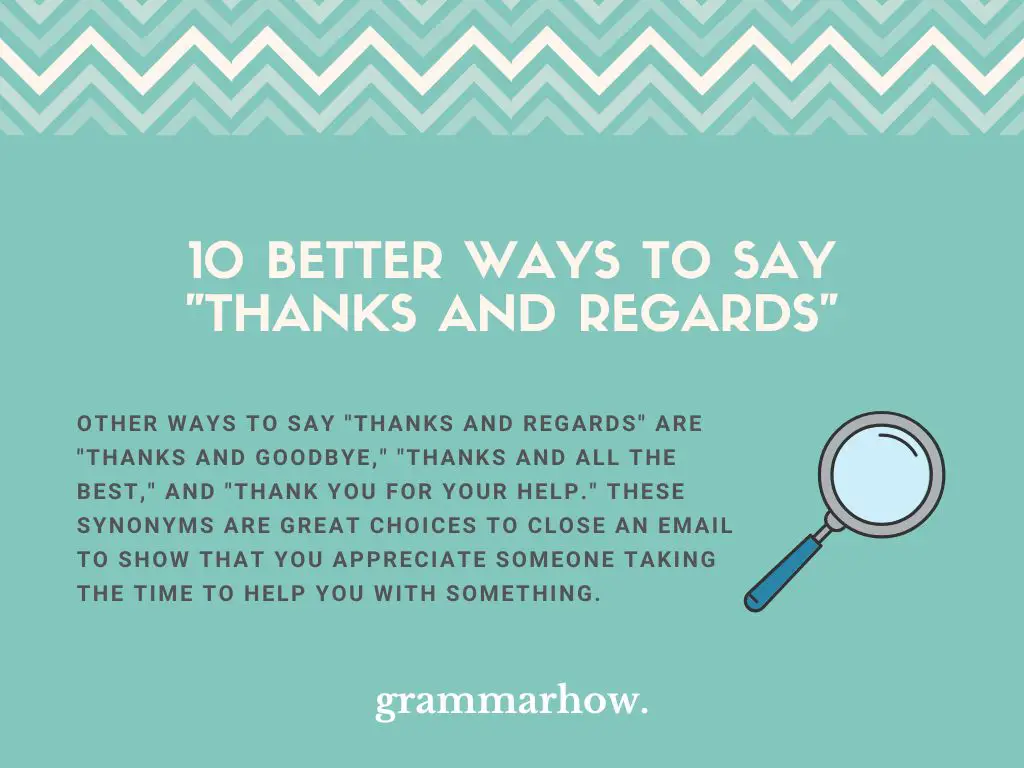Thanking someone and closing an email at the same time can be tricky to get right. This article will explore how to say “thanks and regards” in different formats that you can include in your emails and letters. These alternatives will work in the email’s signature or as the closer.
Other ways to say “thanks and regards” are “thanks and goodbye,” “thanks and all the best,” and “thank you for your help.” These synonyms are great choices to close an email to show that you appreciate someone taking the time to help you with something.

1. Thanks and Goodbye
“Thanks and goodbye” is a simple and conversational way to close an email or letter. You can use it when you want to say goodbye to someone after appreciating them for helping you somehow.
It’s a good choice, but it’s quite conversational. You wouldn’t often use “thanks” or “goodbye” in a formal email or letter. It’s best to keep this one between friends or colleagues who you know will appreciate informality.
- Dear Paul,
- I’m glad we were able to work through these issues. You’ve made it much easier for me to see the solution.
- Thanks and goodbye,
- Roger
- Dear Adam,
- I appreciate the time you took out of your busy day to get this done. You have no idea how much it means to me.
- Thanks and goodbye,
- Dean
2. Thanks and All the Best
“Thanks and all the best” is a slightly more formal option that can work. It shows that you appreciate someone for helping you and want to wish them “all the best” before closing your email.
“All the best” is a fairly popular choice for closing formal emails. That’s why it works well here when you want to use it as a way of saying goodbye.
- Dear Sara,
- I appreciate your kind words. It couldn’t have been easy to come to me with this information before anyone else.
- Thanks and all the best,
- Sam
- Dear Susan,
- I’m glad you took the time to talk me through this. I wasn’t sure if anyone was going to keep me in the loop.
- Thanks and all the best,
- Peter
3. Thank You for Your Help
“Thank you for your help” is a great choice because it shows that you’re closing the email and appreciating someone’s help. You do not always have to include a “regards” sentiment at the end of an email.
Any email closer implies that you are “closing” the email. That’s why they’re known as “closers.” You can use “thank you for your help” without anything else if you want to be appreciative without being too wordy.
- Dear Jon,
- If it’s not too much to ask, I would really appreciate you going to the office and retrieving some files for me.
- Thank you for your help,
- Mary
- Dear Abbie,
- I think you are the best person for the job. I would love it if you could get some of the files completed ASAP.
- Thank you for your help,
- Sue
4. Appreciations and All the Best
“Appreciations and all the best” is a fun way to show someone that you appreciate what they’ve done for you. It shows that you want to wish them well in your closer while also appreciating the work they’ve put in.
“Appreciations” isn’t your typical closer. In fact, it’s never used unless it’s used as a joke in this specific context. It’s a good one to use if you want to show more of a jovial character trait in your emails.
- Dear Ben,
- You are doing a great job with the new team. I haven’t seen work rates like this for a very long time.
- Appreciations and all the best,
- Scott
- Dear Mel,
- I’m glad I have someone like you on my team. I’m not sure what I’d do without you and your abilities.
- Appreciations and all the best,
- Maria
5. Yours and Thank You
“Yours and thank you” can work well in some instances. “Yours” is a typical closer which is short for “yours truly” or “yours sincerely.” “Thank you” is a slightly more formal variation of “thanks.”
- Dear Craig,
- I think I owe you a great deal now. You’ve done wonders with the new project. I couldn’t have done it better myself.
- Yours and thank you,
- Steven
- Dear Arthur,
- You should be proud of the work you achieved while you were here. It’s better than I could have asked.
- Yours and thank you,
- Sarah
6. Thanks and Farewell
“Thanks and farewell” is great if you know you are sending the last email to someone and don’t expect a reply from them. “Farewell” can be used to close emails like this when you don’t expect someone to respond.
If they do respond, it cancels your “farewell” message. That’s why it could be risky to use a phrase like this.
- Dear Maxwell,
- I’m not sure how to say this, but you’ve done me a great favour. I’ll be sure to keep you in mind for that promotion.
- Thanks and farewell,
- Paul
- Dear Steve,
- I appreciate all the time that went into this project. It couldn’t have been easy for you to do this.
- Thanks and farewell,
- Alicia
7. Thank You and Best Wishes
“Thank you and best wishes” combines the simple “thank you” with the common closer “best wishes.” You should use this to wish someone well in a formal context.
“Thank you” works well here because it’s the formal variation of “thanks.” It’s up to you whether you want to use the two-word option over the one-word one. Most people base it on personal preference rather than formality rules.
- Dear Brad,
- I’m glad you’re on my team here. It makes things much easier when we have a worker as diligent as you.
- Thank you and best wishes,
- Kamala
- Dear Paul,
- I knew you would be the best person to ask about this issue. You always know the best way to fix these problems.
- Thank you and best wishes,
- Jon
8. I Appreciate Your Help
“I appreciate your help” is a great way to close an email when someone has offered you help. You don’t always need to use a farewell closer like “regards” or “best wishes,” as “I appreciate your help” already implies that you are ending the email.
Sometimes, a phrase like this works better than the other choices. It’s more concise as it shows that you appreciate someone for a specific reason. It doesn’t go into more detail than that because it’s unnecessary (which is welcomed in formal emails where additional words are redundant).
- Dear Freddie,
- I’m glad you had the chance to go through the files. It’s going to make auditing the paperwork much easier.
- I appreciate your help,
- Micky
- Dear Alex,
- It’s nice to see you working closely with the rest of the team. I always knew you were destined for greatness here.
- I appreciate your help,
- Jamal
9. Thanks a Bunch
“Thanks a bunch” is great, but you can only use it informally. “A bunch” comes after “thanks” in informal situations when you want to show how much you appreciate someone for helping you out.
It’s best to avoid using this in business contexts unless you know your boss (or colleagues) appreciate informal language choices.
- Dear Jonas,
- You have done a lot to help us figure out our next steps. Without you, doing all of this wouldn’t have made sense.
- Thanks a bunch,
- Clark
- Dear Dwayne,
- I think you already know what I’m going to say, but I owe you one. You’ve been such a big help lately.
- Thanks a bunch,
- Adam
10. Cheers
“Cheers” is an informal closer, but it can work in some email contexts. Some employers will prefer the informal language in their work emails, so “cheers” might be a good option.
It works well to say both “thanks” and “regards” because it is such a common closer informally. That’s what makes it such a good option if you’re going to use it in your emails.
- Dear Chris,
- I’m glad you’re on the team, and I wouldn’t have it any other way. You’re such an inspiration to the rest of us.
- Cheers,
- George
- Dear Eddie,
- Thank you for taking the time to run everyone through these issues. I knew I could count on you to help.
- Cheers,
- Lara
Thanks and Regards or Thanks and regards?
“Thanks and regards” is best for formal emails because it works as a closer. You should write it like this:
- Dear sir,
- I appreciate all your help today.
- Thanks and regards,
- Tim
Capitalizing “regards” would cause an issue because “thanks and regards” becomes its own sentence. You wouldn’t capitalize a random word in the middle of a sentence, so you shouldn’t do so with “regards” either.
What Does “Thanks and Regards” Mean?
“Thanks and regards” means you appreciate someone for helping you and want to send them “regards” as a farewell in an email.
It allows you to do two things as a sign-off rather than limiting yourself to one. You can “thank” someone before saying goodbye to them (which is what “regards” does).

Martin holds a Master’s degree in Finance and International Business. He has six years of experience in professional communication with clients, executives, and colleagues. Furthermore, he has teaching experience from Aarhus University. Martin has been featured as an expert in communication and teaching on Forbes and Shopify. Read more about Martin here.
